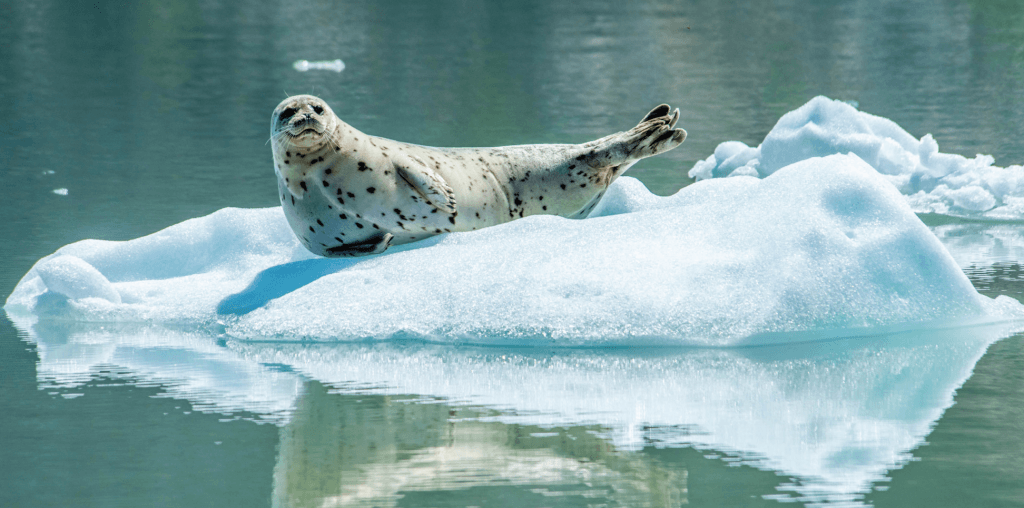
Tracy Arm invigorates locals and visitors
BY STEVE QUINN
WHENEVER I’M ASKED TO IDENTIFY A FAVORITE SUMMERTIME ACTIVITY IN JUNEAU, I MAKE IT CLEAR THERE ISN’T JUST ONE, BUT TWO WORDS STILL COME QUICKLY TO MIND: Tracy Arm. The 45-mile trip to this fjord teems with the region’s signature sights: small pods of killer whales or a few
humpbacks searching for food; eagles perched atop an iceberg’s sharpest point; harbor seals with their recently born pups resting on smaller ice chunks; mountain goats above the tree line; and brown and black bears foraging on the shoreline. It’s a journey not reserved only for travelers. Locals love it just as much, boarding their own boats, kayaks, or one of the commercial excursions leaving each morning from May through mid-September.

Tracy Arm sits south of downtown Juneau, where most departures take place. It’s a fjord—a long, narrow, deep inlet carved out by glaciers over centuries—featuring two tidewater glaciers at its end: North and South Sawyer glaciers. It’s also one of two fjords sitting in the heart of the Tracy ArmFords Terror Wilderness, which received Congressional designation in 1980.
The Wilderness covers more than 650,000 acres of the Tongass National Forest. Both fjords span more than 30 miles with close to 20 percent of the area covered in ice. Tracy Arm, however, is the most accessible of the two and the more popular destination.
A few times each summer, I board one of the Adventure Bound vessels, joining locals, travelers from places as far away as New Zealand and Australia, and kayakers looking to be dropped off for several nights of camping.
The journey led by boat captains Steve or Alissa, who ply the Stephens Passage southbound, can be as much fun as the massive, yet receding and calving glaciers, that await us. Humpback whales on their summer-long search for food that precedes their return to the Hawaiian Islands often join us for several miles of the journey; eagles soar overhead almost as if guiding us; sea lions haul out on nearby Midway Islands, splashing and playing.

To the west 40 miles stands Devil’s Paw, an 8,500-foot peak above Taku Glacier. On a clear day, it appears about an hour after leaving downtown Juneau. This high point of the Juneau Icefield serves as an international boundary peak between the United States and Canada, reminding us
just how close we really are to the border.
The fjords produce significant floating ice with sizes ranging from that of a kayak to some as wide as the smaller cruise ships. Larger icebergs reach Holkham Bay, the entrance to Tracy Arm and gateway to North and South Sawyer glaciers. Some stand three to four stories high, taking on different shapes: humped and crested like camels; squared; or sometimes tilted,
poised to overturn and reveal larger sections submerged beneath the water.
The closer we get to South Sawyer, the more ice there is. Sometimes the entry into South Sawyer is so clogged with icebergs of various sizes, there is no way to safely navigate to the glacier face. Upon arrival, the best place to stand is on the bow. We listen to the crunch of the icebergs against the vessel and feel the air temperature drop the closer we get to the glacier.
Seals and their newborns use the smaller chunks to rest and nurse. They appear as curious about us as we are of them, staring at us with their dark eyes, before making a quick exit back into the water.
Spending time at North or South Sawyer calls for patience. Calving, where large ice chunks break off, produces thunderous sounds as sloughing sections crash into the waters, adding floating bergs for seals to rest upon. It could happen immediately upon arrival. It could take 30 minutes; it could happen just as it’s time to leave. Sometimes, you hear the noise, and other times, you feel it.

Travel windows to the area span five months. May trips reveal more bears along the coasts in low brush areas still lacking leaves. Preceding mild winters can produce more surviving newborn cubs who are curious about their surroundings and unwilling to venture far from mom. Mid-summer excursions can be done under clear blue skies or foreboding low-lying dark clouds, which never deter anyone from going, especially knowing Juneau sits in a rainforest. Precipitation is simply a way of life. September trips afford chances to watch large groups of humpbacks begin migrating south. Already full from a season of feeding, pods head to the Hawaiian Islands for the winter.
With everything the area has to offer, you’ll be booking your next excursion there the moment you disembark.
Steve Quinn is a Juneau-based, award-winning freelance writer and photographer and a frequent contributor to Alaska magazine.
